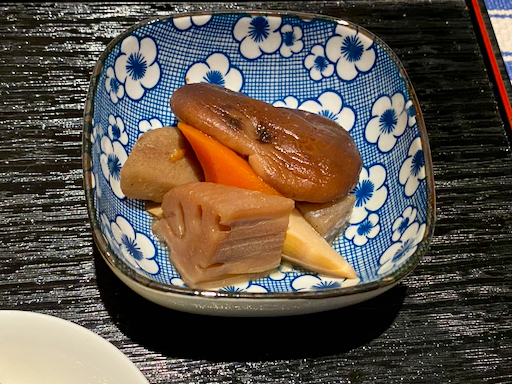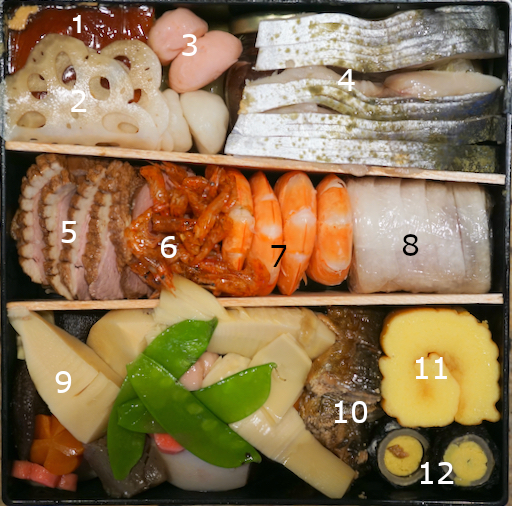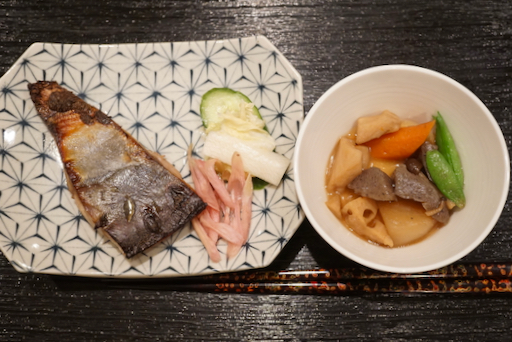Encouraged by my previous success, I again tried distributing the Osechi goodies from the large "mother" box to a smaller mini-osechi box to use as a type of serving container. This was made possible because we found an hexagonal 3 layered stackable container (plastic) with a handle (the handle attaches to the very bottom box) that we completely forgot we had. It was perfect for this purpose and I used the top two boxes. This time, I added some small covered bowls as sides.
One very good thing about this approach is that I can prepared the box ahead of time and keep it in the refrigerator and just grab it when we are ready.
Most of the ingredients came from the Sushi-taro osechi box. #1=sweet simmered "Kuromame" black beans 黒豆, #2="Matsukaze" chicken patty 松風焼き (which I made), #3="
Konnyaku" simmered with Japanese "ichimi" red pepper 蒟蒻一味煮 (has mild zing), #4="Kuwai" arrowhead fried and simmered くわいの揚げ煮 and Simmered Shiitake mushroom 椎茸の旨煮, #5=Plum flower cut simmered carrot 梅人参, #6=Poached chicken tender with salted plum sauce 茹でささ身の梅肉和え(which I made, leftover from making New Year's soup), #7=Miso marinated egg yolk with walnuts 黄身胡桃 (this is also one of our favorite delicacies), #8=Salmon kelp roll 鮭の昆布巻 (which I made), #9=Kelp rolled and cured flounder with "gari"vinegared ginger 平目龍皮巻, #10=Date-maki omelet roll 伊達巻 (Osechi box also had this but this one is what I made), #11= Rib roast with Japanese mustard (leftover from Christmas roast), #12= Miso-marinated herring roe 数の子味噌漬, #13=Pork belly シルク豚味噌漬, and #14=Daikon namasu with "ikura" salmon roe and boiled octopus 大根なますイクラ煮だこ添 (Osechi box did include a more elaborate version of daikon namasu but I served what I made here).

This box contained chicken, beef, pork. I could have added duck since duck "terini" 鴨の照煮 was included in the large osechi box (see below).
This year, I could not get boiled octopus legs and had to be satisfied with the body/head of octopus.
Close up of flounder wrapped and cured in kelp with the center of "gari" ginger. Very refreshing.
"Kimi-kurumi" 黄身胡桃. I think this is egg yolk marinated in miso. Judging from the recipes I found, it would appear that after a few days, the egg yolks attain a very thick unique consistency. In this rendition, walnuts are embedded in the center. We love this dish, although I will not even try to make this myself.
After enjoying these delicacies, we went for the second plates. The big prawns were sake steamed and "bent back" symbolizes long life since old folks in old days all had bent backs or "Koshi-ga-magaru". This dish, in Japanese, was dubbed "longevity prawns" or 長寿海老. We removed the head and, of course, sucked on it and enjoyed the tail. In the center is duck "terini". I suppose
this may be similar to what I make. I served this slightly heated.
The fish is sweet miso marinated Spanish mackerel 鰆西京焼. I heated it in the toaster oven for few minutes. I also added my gorgonzola dried fig chicken patty.
We ate something else for ending dish but do not remember. Having all these prepared osechi dishes is wonderful.
















































